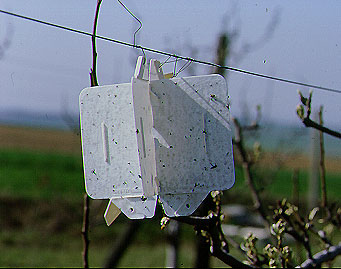Apple sawfly
Hoplocampa testudinea
Appearance
The apple sawfly belongs to the family of true leaf wasps (Tenthredinidae). It is about 7 mm long with a shiny, black-brown body without a wasp waist and orange-brown legs.
The larva is whitish in colour with a brown head capsule and has 10 pairs of legs (3 articulated pairs of legs on the thorax and 7 unarticulated abdominal legs on the abdomen). It can easily be confused with caterpillars of butterflies.
Biology

The flight of apple wasps takes place at apple blossom (from the balloon stage until shortly after blossom). The wasps are attracted by the white flowers and the females, with their saw-like laying apparatus, lay their eggs individually in the cracks they have made in the calyx region of the flowers. Each female lays about 20 eggs. The larva hatches toward the end of flowering and initially feeds only directly under the fruit skin. It then successively eats up to five young fruits inside. A single sawfly larva can destroy an entire cluster of fruit in this way. After three to four weeks, the adult larvae drop to the ground and spend the summer and winter in a cocoon in the upper soil layer. Pupation does not occur until the following March. After that, the new generation of wasps hatches again at the blossoming time of the apple trees.
Damage symptoms

Infested apple fruits show a purple feeding duct under the skin soon after flowering, which is later recognizable as an arch-shaped, brown corking on the ripe fruit. A little later, young fruits are found with holes drilled (down to the core), from which excrement of a jaundiced color emerges. These fruits fall off prematurely.
Prevention and control

- The flight activity of sawflies can be determined with glued traps (white boards). The traps should be set about a week before flowering in the outer crown area, on the sunny side, at a height of approximately 1.8 m. The damage threshold is 20 - 30 wasps per trap at flowering time. If no sawflies are caught, there is no need to worry about sawfly damage. To avoid unnecessarily trapping other organisms, especially beneficial insects, be sure to remove the panels about a week after flowering ends.
- During flowering, visual inspection can be used to determine infestation; the damage threshold is three to five infested fruit clusters (puncture canals on the calyx) out of 100 flower clusters inspected.
- If an infestation with sawflies is to be expected, plant protection products approved for this purpose may be used (see list of plant protection products approved in Austria), whereby the correct treatment date is a prerequisite. The optimum time for control is when the larvae hatch. This date usually coincides with the fall of the petals. The course of egg development and the beginning of egg hatching can also be directly observed by egg inspections with a magnifying glass. In case of chemical treatments, it is necessary to pay attention to a thorough wetting, to the different course of flowering of the different varieties (different egg-laying dates!) as well as to the protection of the bees!
Last updated: 16.09.2024
automatically translated
